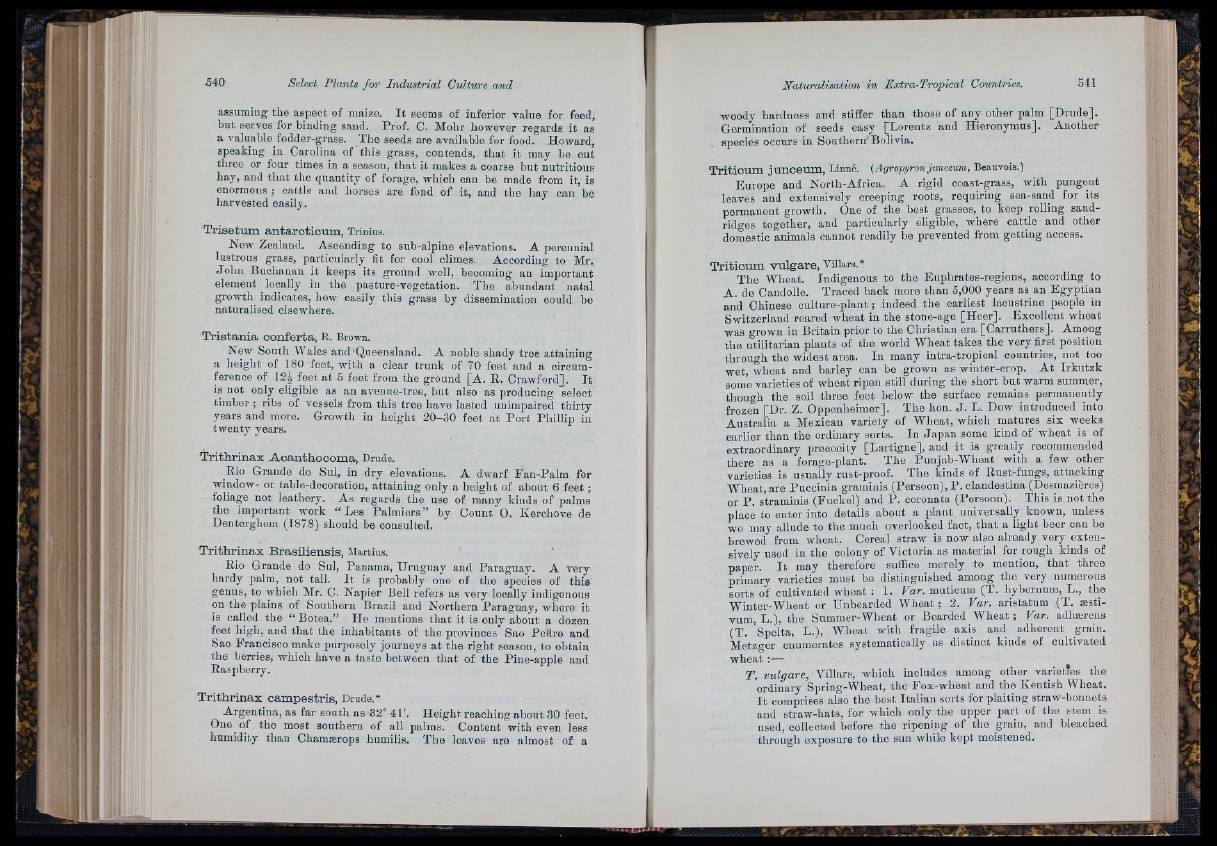
assuming the aspect of maize. I t seems of inferior value for feed,
but serves for binding sand. Prof. C. Mohr however regards it as
a valuable fodder-grass. The seeds are available for food. Howard,
speaking in Carolina of this grass, contends, that it may be cut
three or four times iu a season, th a t it makes a coarse but nutritious
hay, and th a t the quantity of forage, which can be made from it, is
enormous ; cattle and horses are fond of it, and the hay can he
harvested easily.
Trisetum antarcticum, Trinius.
New Zealand. Ascending to sub-alpine elevations. A perennial
lustrous grass, particularly fit for cool climes. According to Mr.
Jo h n Buchanan it keeps its ground well, becoming an important
element ^ locally in the pasture-vegetation. The abundant natal
growth indicates, how easily this grass by dissemination could be
naturalised elsewliere.
Tristania conferta, R. Brown.
New South Wales aud'Queensland. A noble shady tree attaining
a height of 180 feet, with a clear trunk of 70 feet and a circumference
of 124 feet at 5 feet from the ground [A. R. Crawford]. I t
is not only eligible as an avenue-tree, but also as producing select
timber ; ribs of vessels from this tree have lasted unimpaired thirty
years and more. Growth in height 20-30 feet at P o rt Phillip in
twenty years.
Trithrinax Acanthoooma, Dmde.
Rio Grande do Sul, in dry elevations. A dwarf Fan-Palm for
window- or table-decoration, attaining only a height of about 6 feet ;
foliage not leathery. As regards the use of many kinds of palms
the important work “ Les Palmiers” by Count C. Kerohove de
Denterghem (1878) should be consulted.
Trithrinax Brasiliensis, Martius.
Rio Grande do Sul, Panama, Uruguay and Paraguay. A very
hardy palm, not tall. I t is probably one of the species of th is
genus, to which Mr. C. Napier Bell refers as very locally indigenous
ou the plains of Southern Brazil and Nortliern Paraguay, where it
is called the “ Botea,” He mentions th a t it is only about a dozen
feet high, and th a t the inhabitants of the provinces Sao Pedro and
Sao Francisco make purposely journeys a t the right season, to obtain
the berries, which have a taste between that of the Pine-apple and
Raspberry.
Trithrinax campestris, Drude.*
Argentina, as far south as 32° 4P. Height reaching about 30 feet.
Cne of the most southern of all palms. Content with even less
humidity than Chamærops humilis. The leaves are almost of a
woody hardness and stifier than those of any other palm [Drude].
Germination of seeds easy [Lorentz and Hieronymus]. Another
species occurs in Southern Bolivia.
T r itic um ju n c e um , Linné. (Agropyron junceum, Beauvois.)
Europe and North-Africa. A rigid coast-grass, with pungent
leaves and extensively creeping roots, requiring sea-sand for its
permanent growth. Cne of the best grasses, to keep rolling sand-
ridges together, and particularly eligible, where cattle and other
domestic animals cannot readily be prevented from getting access.
T r itic um v u lg a r e , Villars.*
The Wheat. Indigenous to the Euphrates-regions, according to
A. de Candolle. Traced hack more than 5,000 years as an Egyptian
and Chinese culture-plant ; indeed the earliest lacustrine people in
Switzerland reared wheat in the stone-age [Heer]. Excellent wheat
was grown in Britain prior to the Christian era [Carruthers]. Among
the utilitarian plants of the world Wheat takes the very first position
through the widest area. In many intra-tropical countries, not too
wet, wheat and barley can be grown as winter-crop. A t Irkutzk
some varieties of wheat ripen still during the short but warm summer,
though the soil three feet below the surface remains permanently
frozen [Dr. Z. Cppenheimer]. The hon. J . L. Dow introduced into
Australia a Mexican variety of Wheat, which rnatures six weeks
earlier than the ordinary sorts. In Japan some kind of wheat is of
extraordinary precocity [Lartigne], and it is greatly recommended
there as a forage-plant. The Punjab-Wheat with a few other
varieties is usually rust-proof. The kinds of Rust-fungs, attacking
Wheat, are Puccinia graminis (Persoon), P. clandestina (Desmazieres)
or P . straminis (Fuckel) and P . coronata (Persoon). This is not the
place to enter into details about a plant universally known, unless
we may allude to the much overlooked fact, th a t a light beer can be
brewed from wheat. Cereal straw is now also already very extensively
used in the colony of Victoria as material for rough kinds of
paper. I t may therefore suffice merely to mention, th a t three
primary varieties must be distinguished among the very numerous
sorts of cultivated wheat : 1. Var. muticum (T. hybernum, L., the
Wiuter-Wheat or Unbearded Wheat ; 2. Var. aristatum (T. æsti-
vum, L.), the Summer-Wheat or Bearded Wheat ; Var. adhoerens
(T . ’Spelta, L.), Wheat with fragile axis and adherent grain.
Metzger enumerates systematically as distinct kinds of cultivated
wheat ;—
T . vulgare, Villars, which includes among other varieties the
ordinary Spring-Wheat, the Fox-wheat and the Kentish Wheat.
I t comprises also the best Italian sorts for plaiting straw-honnets
and straw-hats, for which only the upper part of the stem is
used, collected before the ripening of the grain, and bleached
througli exposure to the sun while kept moistened.